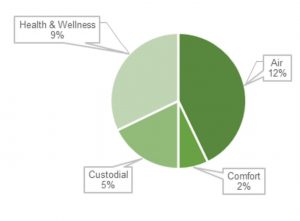
BOMA BEST – Version 3.0
December 17, 2016
By Manasi Koushik, P.Eng., MBA, EP (CEA) and Steven Booth, C.E.T., LEED AP, Pinchin
The next generation of building certification programs is putting much more focus on indoor air quality and occupant health.
From the December 2016 print issue, page. 19.

Graph of IAQ categories within BOMA Best V3. Image: Pinchin.
Addressing health and wellness, occupant comfort, and productivity is a key component of a variety of up and coming building certification programs.
The WELL Building Standard, for example, has made steady gains into the building certification market, with projects registered in Canada and 279 registered worldwide since its release in 2015. The WELL Standard is certified by the Green Business Certification Incorporation (GBCI) which is also the certification body responsible for certifying LEED buildings. WELL is designed to work with LEED buildings and is supported and promoted by GBCI and the Canada Green Building Council.
The U.S. federal government’s GSA (General Services Administration) and CDC (Centers for Disease Control and Prevention) with the Center for Active Design are in the process of launching the Fitwel building certification process. These new certification systems are also focused on improving employee health and wellness, thereby increasing overall productivity.
BOMA Canada (Building Owners and Managers Association) has a building certification program that recognizes excellence in energy and environmental management and performance in commercial real estate. BOMA BEST has long been a go-to building certification standard with respect to energy and environmental sustainability for building types such as office buildings, enclosed shopping centres, open air retail, light industrial, multi-unit residential and healthcare facilities.
BOMA BEST widens its reach
Reflecting aspects of the new wellness standards, the new version of BOMA BEST widens its focus and considers occupant health and wellness as a key priority. Significant changes to BOMA BEST V3 are the expansion from 14 to 16 BEST Practices and 6 to 10 key areas of environmental performance and management. The BEST Practices are the minimum requirements to achieve BOMA certification. A building can increase the number of points to achieve higher levels of certification by improving on the 10 key areas of environmental performance and management.
New BEST Practice requirements include an Indoor Air Quality (IAQ) Monitoring Plan, Hazardous Chemical Products Management Plan, Green Cleaning Program and a Hazardous Building Materials Management Program, which now includes Silica.
The 10 key areas of environmental performance and management for V3 are:
➤ Energy ➤ Purchasing*
➤ Water ➤ Custodial*
➤ Air Quality ➤ Waste
➤ Comfort* ➤ Site
➤ Health & Wellness ➤ Stakeholder Engagement*
* new
Important to note is that three out of the four new categories involve an aspect of IAQ action and awareness. These changes ensure that in addition to energy and water conservation, occupant health and comfort take centre stage.
Focusing on the requirements for office buildings under BOMA V3, there are typically 1,000 points that can be awarded to buildings. The IAQ categories: air, comfort, custodial and health and wellness in combination account for 28% of the overall achievable points. In comparison, energy and water sustainability account for 30 to 35% of all achievable points. The percentage breakdown of each category is shown in the graph at left.|
IAQ Monitoring Plan
BOMA BEST V3 ensures that an IAQ Monitoring Plan is present in all certified buildings. The BEST Practice is closely in line with industry best practice. This includes setting standards for common indoor air quality contaminants, setting a schedule for HVAC inspection and maintenance, creating a preventative maintenance plan, developing a response procedure should IAQ concerns arise, and finally, training for building staff on IAQ issues. This type of IAQ management plan along with IAQ testing and assessment can help avoid potentially costly indoor air quality problems down the road.
Legionella and Radon
Two other areas of IAQ where the requirements of BOMA BEST V3 have increased include Legionella and radon. Legionella in potable water systems and cooling towers presents a risk to occupants when that water is aerosolized at faucets, showers and in the cooling tower drift. Radon is a gas that is naturally occurring throughout Canada and, being both colourless and odourless, is not detectable without testing. BOMA has added these new criteria:
– the implementation of a Legionella Bacteria Control Management Program compliant with ASHRAE 188 and the Public Works and Government Services Canada’s “Control of Legionella in Mechanical Systems”; and
– testing for radon and the implementation of mitigation measures where there are exceedances above the Health Canada action limit of 200 Becquerel’s per cubic metre.
The final destination
Although BOMA BEST continues to be focused on sustainability initiatives, based on how the points are weighted within the BOMA BEST assessment, it is clear that IAQ management and practices account for a large percentage of the overall points.
The BOMA Best V3 guideline and questionnaire can be found at http://bomacanada.ca/bomabest/resourcesupdates/v3guide/cce
Manasi Koushik, P.Eng., MBA, EP (CEA) and Steven Booth, C.E.T., are with Pinchin. The Pinchin Group of Companies is based in Mississauga, Ontario and has provided engineering, consulting, testing and project management services related to environmental management and health and safety since 1981.